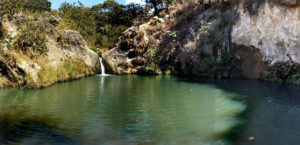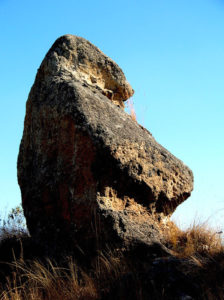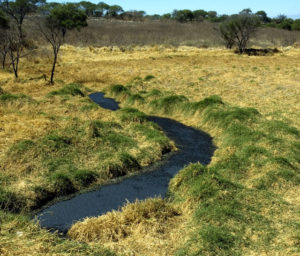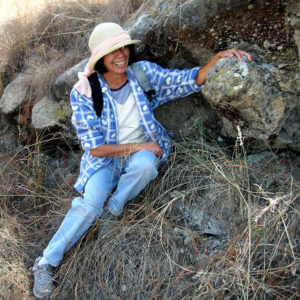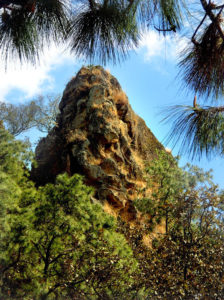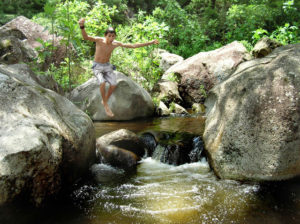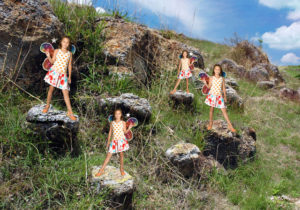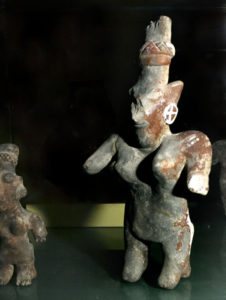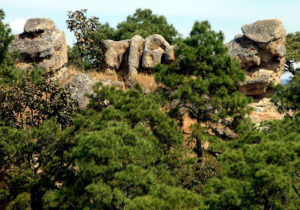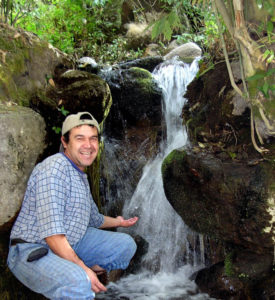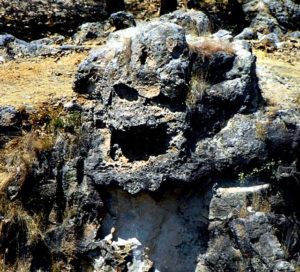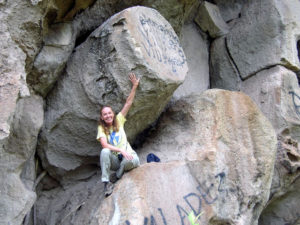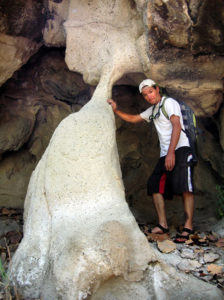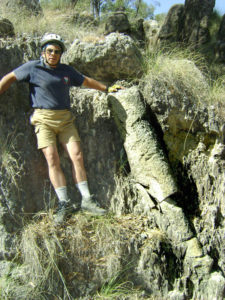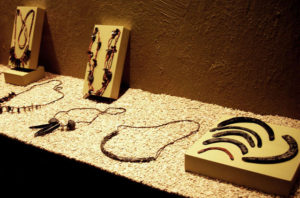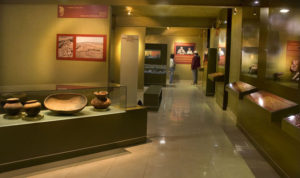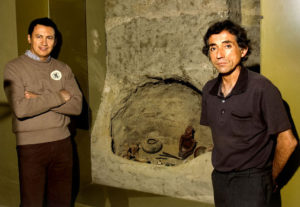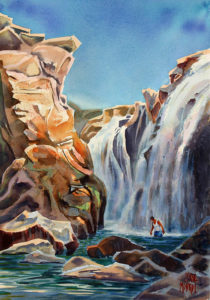Tala is a small town located 30 kilometers due west of Guadalajara and best known for its large, government-operated sugar refinery, infamous for being the major polluter of Lake La Vega.
Two thousand years ago, however, Tala was the residential district of a large metropolis with a population of some 60,000 people. “Most likely,” says archeologist Rodrigo Esparza, “in the days of the Teuchitlán civilization, the great majority of its people lived in and around what is now called Tala, which was rich in woods, water and obsidian deposits, while the nearby Guachimontones were reserved for official business and ceremonies.”
The name Tala in fact, is a corruption of “Tlallan,” which means “Place of Arable Land.” Around 1000 A.D., after the decline of Teuchitlán, the settlements in the Tala area coalesced into an independent town.
Proof of Tala’s heritage is the fact that bits and pieces of its past keep turning up anywhere people dig a hole. The importance of the pots and artifacts unearthed by his fellow citizens became a matter of concern to local artist Guadalupe Romero some 25 years ago.
“I began to talk to the tomb raiders, trying to prevent these marvelous finds from leaving our town,” says Romero, who built up a large collection over the years, most of which he has donated to the museum of which he is now the curator. In the past, in numerous small communities in Mexico, such collections were typically stored on shelves — the more pieces per square foot the better — and mislabeled, if labeled at all. Here they often gathered dust, forgotten and rarely seen by anyone.
Tala’s Archeological Museum
This may have been the case in Tala once upon a time, but no more. In December of 2009, a modern museum designed by Jalisco archeologists and architects opened its doors, featuring one of the best collections in the state.
The new museum has some 350 pieces in tasteful, well-lit, ultra-modern display cases spread among six rooms.
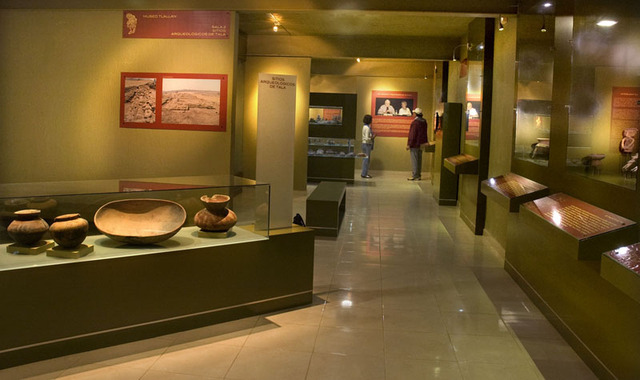
Of particular note is a rare collection of obsidian jewelry featuring two very different styles of necklaces. “A lot of obsidian jewelry was found in this area,” says Rodrigo Esparza, “because this kind of obsidian was a specialty of the nearby deposit of San Juan de los Arcos, where we found unique ‘cores’ designed specifically for producing the thin, flat sheets needed for some kinds of jewelry. These layers of obsidian were only 2 to 3 millimeters wide.” Of particular interest in the Tala Museum display is a necklace of tiny human figures made of this very thin obsidian. Each one, of course, has a minuscule hole in it for stringing. The fact that people 2000 years ago — having no metal tools — could shape such thin flakes of natural glass and put holes in them, is surprising.
Other particularly interesting displays in the museum show figurines of people with artificially elongated heads and pointy ears, which the Spaniards mistook for horns, naming such figures “diablitos” (little devils). The museum also has fine examples of Oconahua Red-on-White ceramic plates. Because these contain up to 70% kaolin, they are exceptionally fine, thin and white, decorated with unusual geometric figures.
The museum also has a fine representation of a shaft tomb, a specialty of this part of Jalisco, going back to 1000 years before Christ. The deepest known of these vertical tombs is at San Juan de los Arcos, just outside Tala and measures 22 meters deep. While most shaft tombs have been found already looted, the one untouched tomb found by archeologists, at Huitzilapa in 1996, yielded a staggering 67,000 artifacts.
Large placards with descriptions and photos accompany each display case and two slim, wall-mounted computer screens allow visitors to easily navigate the museum. In addition, the museum features a large painting by its Director, José Guadalupe Romero, presenting the artist’s view of Tala and Teuchitlán at the area’s apogee in the year 200 A.D.
Tala’s newly revamped museum is open Monday to Friday from 9 to 3 and 4 to 5. It is housed in the town’s Casa de Cultura, located at 91 Calle Nicolas Bravo at the corner of Cabañas. You can call ahead, to make sure the place is really going to be open; telephones: (01 384) 738-0005 or 735-0088 or 738-0054. Admission is free.
Happiness On the Rocks
While archaeologists speculate that the ancient inhabitants of western Mexico decided to live in Tala because of its arable land, rivers and obsidian, there is one other feature of this area which anyone, ancient or modern would find both attractive and extraordinary: the bizarre rocks which abound north, south and east of the town.
The easiest way to see these rare geological formations is by visiting Villa Felicidad, a housing development that — fortunately for nature lovers — never developed. Here you will find two square kilometers of pine and oak forest housing no end of big volcanic rocks which come in a wonderful variety of fantastic shapes. This is a place where you can let your imagination run wild. You’ll see rocks that look like long, meandering walls, stairs leading nowhere, elephants, Easter-Island-type giant heads, Cookie Monsters — you name it.
Felicidad, of course, means happiness and this is indeed a happy place for naturalists, although the people who bought land here years ago might not agree, since a good number of them lost their shirts when the developer ran off with their down payments, having “developed” nothing more than a short stretch of paved road and a few light poles.
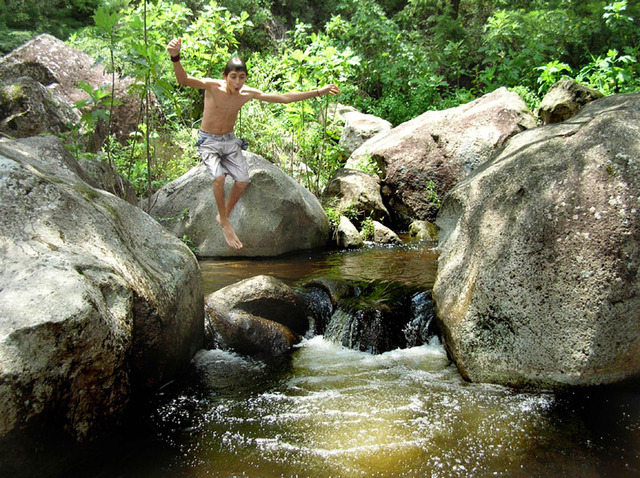
One Sunday, as we drove through Villa Felicidad, we came upon the present-day owner of the land, Hugo Castellanos. Sitting on his motorcycle on the side of the road, he would chat with the drivers of each carful of visitors that came along, always ending with, “…and remember not to leave any garbage!”
Castellano’s efforts seem to have paid off, because Villa Felicidad is remarkably clean considering its proximity to a town.
The great variety of curiously shaped rocks at Villa Felicidad is probably due to the result of ancient pyroclastic flows blanketing an area of lakes and rivers. Among the variety of rocks here are many that resemble stone columns, which experts say were created when steam or gases bubbled up through the fallen tephra. These particular phenomena are called “fossil fumaroles” and you can see them all over Villa Felicidad, where they sometimes resemble tree stumps made of stone and which, for years, we referred to as “Fairy Footstools.”
Driving east out of Tala on the extension of Luis Rojas Street, you’ll pass right through the middle of Villa Felicidad and you can easily find flat, grassy places where you can get off the road and park under a shady tree to enjoy a picnic lunch. If you go there on a Sunday, you may also encounter the problem of noisy motorcycles spoiling your contemplation of the enigmatic piedras grandes, so I suggest you visit this enchanting place on a weekday. Happiness, it seems, sometimes comes at a price, but the beautiful scenery, fresh air and exercise are well worth it.
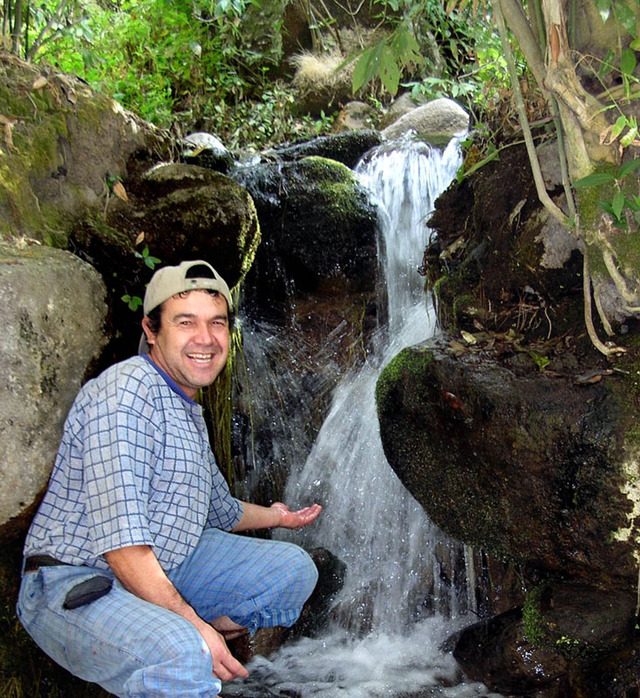
Hugo’s Heavenly Pool
On one of our many visits to this fascinating area, Hugo Castellanos told us about a hidden-away swimming hole and waterfall that few people have ever seen. It turned out to be one of those idyllic patches of paradise perfect for a movie backdrop and we call it Hugo’s Heavenly Pool.
The easiest way to find it is to follow the small stream which runs along the northern edge of this beautiful area. This little river is known as El Río Zarco and its source appears to be in an uninhabited part of the Primavera Forest, only two kilometers east of Villa Felicidad, suggesting that its waters may be as clean and unpolluted as they look. By the way, the word zarco means something like “cloudy,” referring to mineral content in the water of a stream or pool, but in no way suggests that the water is unfit to drink.
During most of its route, the Río Zarco runs along the bottom of steep slopes and we wondered if we would find a path that might take us down to the Heavenly Pool.
We walked west along the northern perimeter of Villa Felicidad until we spotted the Río Zarco about 23 meters below us. All along our route we kept bumping into strange rock formations: “This one looks like the mouth of a snake. That one is a frog… and this looks just like a man-made wall.” We even found a few perfectly rectangular “stone blocks,” but close examination always revealed that what we were looking at was nature’s handiwork.
After an hour’s walk, we reached a lookout point from which we could see — far below us — a turquoise pool of water fed by a frothy white waterfall. Hugo’s Pool, at last! We clambered down and soon found ourselves on a little beach.
The mini-lagoon turned out to be a lot bigger and deeper than it appears from above and the water much cooler than I would have guessed. This glowing green pool even comes with a little sandy beach where you can lie back and contemplate the funny-looking rocks decorating the gently sloping hillside to the north, a hillside where you could also go exploring, if you wanted to, confident you’ll not bump into a single featherless biped.
Ghostly River
Amazing to say, there is another cool, clean and much bigger river near Tala, just on the other side of Villa Felicidad. Like el Río Zarco, the Río de las Animas is born in the Primavera Forest and after it skirts Tala, it flows into Lake La Vega. I used to call it “The River of Souls until I learned that there are two words for soul in Spanish: alma and ánima. The former refers to the souls of living persons as well as those who have made it to heaven or that other place. An ánima, however, has not yet reached its final destination. This word covers the souls in Purgatory as well as the ones you find wandering about cemeteries, haunted houses and the new Teuchitlán Interactive Museum (where the night guards have spotted dozens of ánimas, perhaps once belonging to the skeletons unearthed while digging the building’s foundation.
So, I am calling it The River of Ghosts, a name it might possibly have received long ago by someone who noticed the above-mentioned bizarre rocks and fossil fumaroles found along its banks.
You reach this river by passing through Tala and continuing east through Villa Felicidad. Four kilometers from the edge of Tala, you come to el Río de las Animas. From this point, if you head upstream, you’ll quickly come to a spring where clean, warm water gushes out of the hillside and cascades over a small fall into the river. Three hundred meters upstream from here, there’s a small, natural bathing pool next to a wide meadow perfect for camping, at the edge of which you’ll find several fossil fumaroles of extraordinary size. One we measured at 1.2 meters in diameter. I wonder if bigger examples of such formations can be found anywhere in the world.
The Chocolaty Chorros de Tala
There’s a beautiful waterfall and recreation area just north of Tala where you can rent a bungalow or camp for a very reasonable fee. This place is called Los Chorros de Tala and features a remarkable waterfall over a cliff of smoothly rounded, chocolate-colored basalt rock with a natural swimming pool beneath it. The river you see here is El Río Salado (The Salty River), the cooled-down continuation of the famous Río Caliente in the Primavera Forest.
What most visitors to this site don’t know is that there is a magnificent hiking area just north of and all along the road leading to Los Chorros. This is filled with weirdly shaped rocks like those in Villa Felicidad, resembling sofas, armchairs, bathtubs, curving walls and tall pinnacles.
The big advantage of these “Magic Rocks” above all the others around Tala is easy access. The road to Los Chorros is fine for any sort of vehicle. Just drive 4 kilometers north of Tala on highway 70 and turn right at the Chorros sign. After another 600 meters you can park anywhere along the road. Now walk north about 200 meters and then wander in an easterly direction and enjoy the magic.

